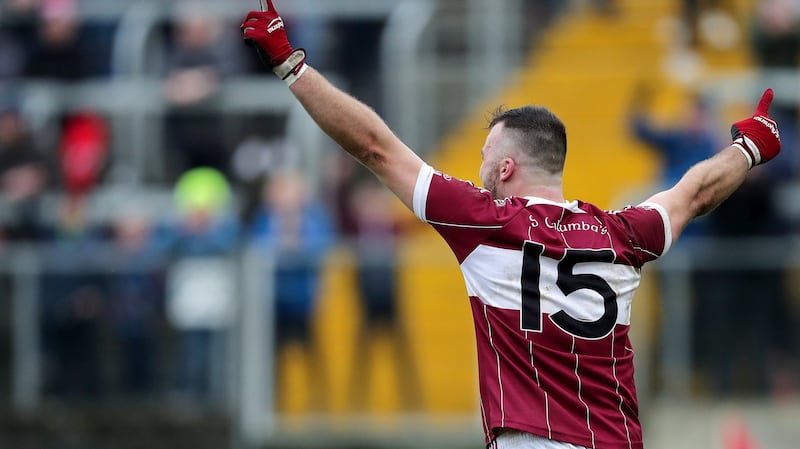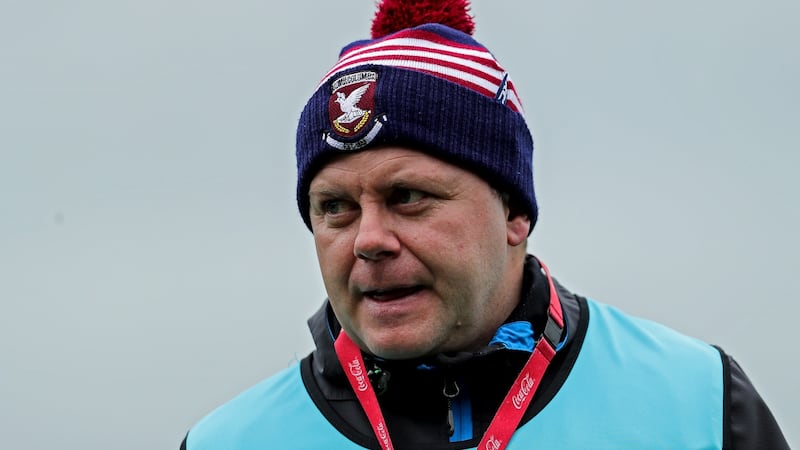The local pitch has been called The Laurels for as long as anyone can remember. It's a pleasant name with a practical explanation. The bank of laurel trees across one end of the field doubled as a changing room for decades. John Keegan, Mullinalaghta's chairman, remembers the realities of games there before the dressing room facilities were built in the 1980s. "If you had wet day, the clothes you took off were as wet as what you were wearing. So it was fairly primitive at that time."
Mullinalaghta are old football stock in Longford, with senior county championship titles dating back to 1948 and 1950. But the place is also a geographical curiosity, formerly part of the parish of Colmcille which was restructured so that the east side was consigned to Lough Gowna, in Co Cavan while Mullinalaghta stayed in Longford.
"We ended up as a half parish," says Keegan. For GAA people in the locality, it meant two radically differing experiences. Gowna was part of Cavan's rich Ulster lineage and the club itself became a force in the 1990s and early 2000s, with Eamon Coleman among their coaches as six county championships were accumulated. "There was a time," Keegan says, "when Gowna would have been the envy of everyone in this part of the world. But like all rural clubs, that faded after a while. They are coming back now with some good new teams."
Golden years
These past few years, however, have been Mullinalaghta’s golden period. After winning nothing since 1950, they have somehow bagged three Longford titles in a row and now face Kilmacud Crokes in Sunday’s Leinster final. It is, literally, a fantastic story. But it’s no fairytale. It has come about through resourcefulness and nimble thinking and a refusal to accept a pre-determined role.
If only we could win one bloody match."
Tired of fielding juvenile teams incapable of competing with teams from Slashers or Clongish, the neighbouring clubs of Mullinalaghta and Abbeylara pooled their resources into an underage club called Northern Gaels. They got them playing seven-a-side games when there weren’t enough numbers.
“It was a brilliant competition because it meant that everyone got a lot of touches,” explains Dan McElligott, who has five sons on the squad on Sunday. “All we could do was to get them out playing football.”

It didn't lead to automatic success on the scoreboard. There were years when winning was something the other crowd did. McElligott remembers one kid in sixth class, Brian Buckley, marching into the dressing room one day, bag on his shoulder, bracing himself for another long day on the pitch. "Awwh Jaysus," he said to nobody in particular. "If only we could win one bloody match."
The phrase bounced around McElligott’s mind for years. It was a reasonable ambition. And eventually, it started to happen. McElligott is an out-and-out Kerry man transported to the midlands first to work as a psychiatric nurse who stayed because his wife, Bernie, was from Mullinalaghta. McElligott found a place just as immersed in Gaelic football as his own patch in Kerry, Ballymacelligott. But in Kerry, the emphasis was always on the next season: the next achievement. The references in Mullinalaghta to the championship side of 1950 were frequent and reverential.
“They were nearly burned with history. They were listening to stories about the ‘48 and ‘50. It was almost like Setanta and Fionn Mac Cumhaill: they were lovely to hear but they didn’t resonate as something real.”
Serious coaching
With coaches like John Reilly, they began to look forward again. The Northern Gaels alliance was vital for giving youngsters confidence and a taste of winning. Seven of Sunday's side were on the Gaels team that won the All-Ireland Feile in Derry in 2010. James Carroll, a teacher in Cnoc Mhuire in Granard where the majority of Mullinlaghta students attended secondary school, had begun to give serious after-school hours coaching. The 2013 side won the All-Ireland vocational final in 2013. You could feel the momentum among the young players from Mullinalaghta. Then, in 2014, the club reached a Longford senior final against Killoe St Emmets.
“And lost it,” says Keegan. “It was inexperience. It was a particularly windy day and we tried to play football into a gale rather than just defend and went in eight points down. The other team just played defensively in the second half and we couldn’t bridge it.”

When Keegan heard that Mickey Graham was stepping down after spending two years managing Clongish, he got in touch. They met for a cup of coffee in Cavan town. Graham hadn't planned on further management in Longford but knew of Mullinalaghta's progress and agreed to take up the vacant senior management position. For three successive years, they've been the best team in Longford. Graham has been the perfect fit for where the club and team is at.
“He is a very good people manager,” says Keegan. “Fellas of a certain age sometimes need a bit of driving and leading. Mickey never raises his voice but everyone knows who the boss is. That’s a great art. He brings people with him. He has instilled, in my view two things: discipline and confidence. If they spill a goal against the run of play, there is no panic or giving out. Just: win the next ball.”
It’s hard to measure the sense of local pride and energy generated by the success. In one way, it’s completely locked into club pride and in another, it has nothing to do with it. Most of the players live and work elsewhere. The car lights appear at The Laurels each Wednesday night when the players arrive from Dublin, Galway, Limerick, Dundalk.
Unseen, unheard
The players travel at their own expense. It would be easier to transfer, to sign with a big urban club. But no. “People appreciate that effort,” Keegan says. They held a small fundraiser last Sunday: just a 5k walk posted on Facebook. It rained cats and dogs. Still, they had two and a half grand at the end of it.
“That, to us, is major money. We don’t have a main street with shops to get sponsors. We are pulling from the same people all the time.”
And when did the country hear about Mulllinalaghta before its football team began making sounds? Two months ago, the local post office closed. They made a presentation to the post master and accepted that the community had lost one more social outlet. It confirmed a general feeling. “People here believe that rural Ireland is being forgotten and that we don’t matter to the people in Dublin,” says Keegan.
“And we don’t. The problem is that we don’t have any industry and don’t have anyone fighting for industry. We have no TD in the Dail representing Longford. I am sure the lads in Westmeath would say they are working fervently but if you look at the level of employment in Athlone and Mullingar compared to Longford, it speaks for itself. Center Parks is the only good news story Longford has had in a long time. The boom period hasn’t happened here. There’s probably not 10 houses being built in the county here. Compare that to what is happening in Navan or Naas or any of the satellite towns.”
There are 834 affiliated GAA clubs in Leinster. Almost all of them are bigger than Mullinalaghta. In the pecking order, they should be unseen and unheard. And yet here they are: Mullinalaghta, pop 440, the Longford champions, the half-parish, one of the last two teams standing in the province.



















